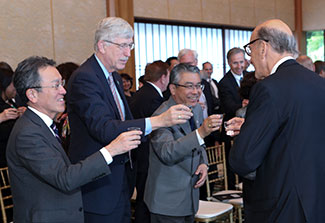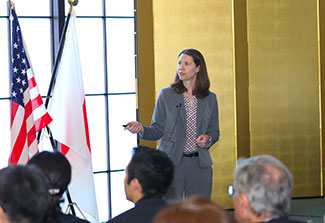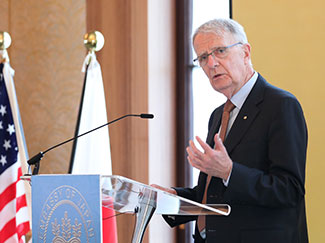Three decades of frontier science advances celebrated with HFSP
May / June 2019 | Volume 18, Number 3

Photos courtesy of the Japanese Embassy
Japan and the U.S. toasted the 30th anniversary of the Human
Frontier Science Program. From left, Japan’s Deputy Science
Minister Yoshio Yamawaki, NIH Director Dr. Francis Collins,
Japan’s Ambassador to the U.S. Shinsuke Sugiyama and
Fogarty Director Dr. Roger Glass.

Annual budget: $55 million
Research project grants: projects must involve a new area of exploration for the scientists and include a multidisciplinary and international research team, which has not previously worked together, with the lead investigator located in an HFSP member country.
Postdoctoral fellowships: postdocs from any country can receive support to pursue a new field of inquiry at the world’s best lab in that field.
HFSP members (in alphabetical order): Australia, Canada, European Union, France, Germany, India, Italy, Japan, the Republic of Korea, Norway, New Zealand, Singapore, Switzerland, the United Kingdom and the United States.
Website:
www.hfsp.org
Thirty years ago, as the Cold War was ending, the leaders of the major industrialized nations conceived an optimistic vision for a new world order based on strong international partnerships and stunning scientific discoveries. Together, G-7 leaders established the
Human Frontier Science Program (HFSP), a research funding body that for three decades has nurtured early-career scientists with audacious ideas and supported global teams to conduct cutting-edge research.
Scientific leaders, policymakers, advocates and grantees gathered recently at the Japanese Ambassador’s residence in Washington, D.C. to toast HFSP’s accomplishments and recall its genesis.
HFSP’s founders viewed research as a uniting force for progress and prosperity, noted HFSP Secretary-General Professor Warwick Anderson. “They shared the hope, the belief, the understanding that science was a powerful way to promote international cooperation, collaboration and dialogue.” (Read Fogarty's Q and A with Professor Anderson.)
Since its establishment, HFSP has funded about 7,000 scientists in nearly 70 countries, with 28 of them going on to win a Nobel Prize. The organization has grown to include 15 members that jointly support its $55 million annual budget, with Japan and the U.S. providing the largest contributions.
Because HFSP funds high-risk, high-reward research on new areas of inquiry without requiring preliminary results, it can support paradigm-shifting work that lays the groundwork for more conventional funders, such as its U.S. partners, the NIH and the National Science Foundation (NSF).
“We need to celebrate the way in which this has caused advances across the world that have given us insights into how life works, and how disease happens and how to save lives,” according to NIH Director Dr. Francis S. Collins. “This has greatly benefited the U.S., for which we are grateful, to have all that talent come to our shores, or to take part in collaborative efforts.”
The synergy among organizations is valuable, noted NSF Director Dr. France Cordóva. “HFSP and the NSF share the same goals: to foster research that expands our knowledge at the very frontier of how we understand the physical world, to make it possible to take risks that may have revolutionary payoffs, and to enable the scientific community to push itself further than it has before.”

Dr. Diane Lidke presented on how an HFSP early-career award
helped kick-start her career.

HFSP Secretary-General Professor Warwick Anderson
welcomed attendees.
To illustrate the tangible outcomes of HFSP funding, two grantees presented their research discoveries. An HFSP early-career award helped kick-start the career of Dr. Diane Lidke, associate professor at the University of New Mexico. She said her research - visualizing protein dynamics to identify the molecular mechanisms that alter signaling in cancer and the immune response - requires a multidisciplinary approach.
“What I really believe in is collaborative science, or really team science, because the kind of questions we’re addressing require a broad skill set.” A biophysicist, her HFSP support allowed her to expand her network of chemists, computational scientists, mathematicians and medical doctors beyond the U.S. to include collaborators in the Netherlands, Spain, Germany and India. Her work, which is now funded by NIH, has the potential to contribute to cancer treatments and other applications.
Dr. Duncan Irschick, an integrative biologist and inventor at the University of Massachusetts Amherst, said his 2012 HFSP award to investigate the mechanisms geckos use to climb was the kind of passion project that “reminds us why we became scientists.” The discoveries from that grant led to development of a patented adhesive called Geckskin, as well as the inspiration for an imaging system known as Beastcam, to create accurate 3D models of life on earth.
Other key advances from HFSP-funded research include discovery of the sonic hedgehog gene, which led to a treatment for basal cell carcinoma; findings that show anti-diabetic agents may provide protection against Alzheimer’s disease; and development of nanoparticles that can effectively deliver drugs directly to tumors using swarm behaviors.
HFSP hopes to be able to continue to expand and is reaching out to potential new member countries with strong life sciences programs in Africa, the Middle East and Latin America, according to Anderson.
That bodes well to ensure the next three decades are as exciting and productive, said Fogarty Director Dr. Roger I. Glass, who is NIH’s representative to HFSP’s board of trustees. “HFSP science is cutting-edge, it’s highly competitive, it’s interdisciplinary,” he said. “It’s bringing the best and the brightest from around the world together in teams, united by their tremendous passion and love of science. It’s the excitement at the intersection of disciplines that really makes this extraordinary.”
More Information
To view Adobe PDF files,
download current, free accessible plug-ins from Adobe's website.